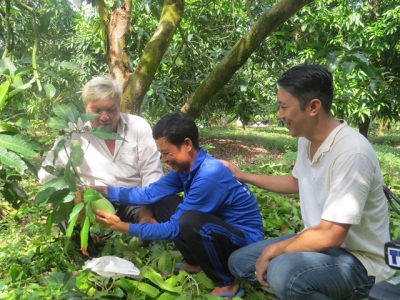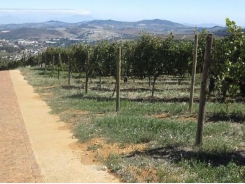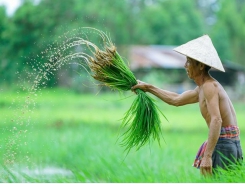Đồng Tháp farmers grow mango in off-season to stagger supply, sustain prices

ĐỒNG THÁP – Đồng Tháp Province, the Cửu Long (Mekong) Delta’s largest mango producer, is staggering its production of the fruit to improve farmers’ incomes.
Farmers tend mangoes grown to VietGAP standards in Thanh Bình District’s Tân Hòa Commune in Đồng Tháp Province. – Photo baodongthap
The province has 9,648ha under mango, almost a fifth of the delta’s total mango area, and grows 127,000 tonnes, annually.
Of this, 6,300ha produce the fruit in the off-season, according to the province’s Department of Agriculture and Rural Development.
Prices in the off-season are often VNĐ10,000 per kilogramme higher than in the main season.
The province has developed six models for growing clean mango on a total area of 416ha in Cao Lãnh District and Cao Lãnh City.
Đoàn Thanh Hiền, a member of the Mỹ Xương Mango Co-operative in the district, was one of the first to grow clean mangoes in the off-season.
"This model helps stagger supply over the year and reduce oversupply," Hiền said.
Besides, it provides farmers with 1.5 – 2 times the normal income.
The main mango season is April-May.
Nguyễn Phước Thiện, deputy director of the department, said the province had a number of solutions to restructure agriculture, which include fruit farming models such as growing mango in the off-season.
The province would continue to restructure mango production and instruct farmers in techniques to grow the fruit in the off-season to meet export quality standards, he said.
Đồng Tháp’s mangos are exported to Japan, Australia, South Korea, and the US.
Its main varieties are Cát Chu and Hòa Lộc, which account for 70 per cent and 20 per cent of the farming area.
More farmers in the province are growing the fruit to good agricultural practice (GAP) standards like VietGAP and GlobalGAP.
Farmers use bags to cover the fruits on around 85 per cent of the growing area.
The province has eight co-operatives and 29 co-operative teams that grow mango under contract for processing companies.
Trần Quốc Đạt, head of a mango co-operative team in Thanh Bình District’s Tân Hòa Commune, said his 1.3ha orchard had been VietGAP-compliant for nearly two years.
He set up the co-operative team together with three neighbours.
Phan Thị Như Quỳnh, an agricultural official in Tân Hòa, said more than 45ha of the commune’s 230ha of mango were compliant with VietGAP standards.
Most farmers were aware of the demand for quality mangoes and so join hands to grow them, she said.
Commune authorities have called on companies to sign contracts with farmers to ensure outlets for their fruits.
Đồng Tháp grows 181ha of mango to VietGAP standards and 43ha to GlobalGAP standards.
It harvested 76,450 tonnes in the first half of this year.
Có thể bạn quan tâm
Phần mềm

Phối trộn thức ăn chăn nuôi

Pha dung dịch thủy canh

Định mức cho tôm ăn

Phối trộn phân bón NPK

Xác định tỷ lệ tôm sống

Chuyển đổi đơn vị phân bón

Xác định công suất sục khí

Chuyển đổi đơn vị tôm

Tính diện tích nhà kính

Tính thể tích ao hồ



 South African company to export fresh grapes to…
South African company to export fresh grapes to…  Vietnam wants to be top 15 organic farming…
Vietnam wants to be top 15 organic farming…